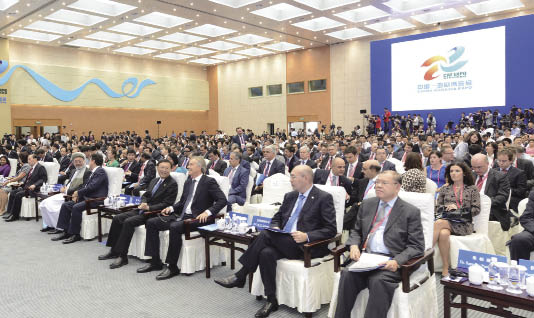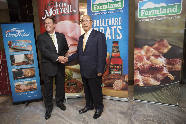The China-Eurasia Expo
The first China-Eurasia Expo held in 2011 included forums and activities themed on economic development and cooperation between China, other Asian countries and Europe. Then Vice Premier Li Keqiang made the keynote speech in which he proposed pragmatic cooperation on trade and investment, stronger interdependence in infrastructure, and improved mutual beneficial cooperation between industries and companies. Representatives of the countries present unanimously endorsed these goals, and leaders expressed hope of greater regional cooperation and investment.
The 2011 Expo covered 79,500 square meters, 42,000 of which was indoors and 37,400 outdoors, with 3,802 stands representing different regions, industries, new and hi-tech, and industrial parks. Expo participants consisted of 20,000 domestic guests and 4,000 foreign purchasing agents. Total visits exceeded 315,800 over the five days. The event presented 507 investment and cooperation projects, staged 29 trade and investment promotion, negotiation and inspection activities. The volume of transactions reached US $5.5 billion, of which US $2.375 billion was for exports, US $2.233 billion for imports, and US $898 million for international economic and technological cooperation projects. Xinjiang signed 178 contracts with other places in China valued at RMB 185 billion.
|
 |
| The opening ceremony of the second China-Eurasia Expo on September 2, 2012. Ma Jianrui |
The second China-Eurasia took place in Urumqi from September 2 to 7, 2012. Then Premier Wen Jiabao was present at the opening ceremony and the main forum. Leaders from Kyrghyzstan, Maldives, Cambodia, Kazakhstan, Tajikistan, Afghanistan, Turkey, the U.K., and former Prime Minister of the Netherlands Jan Peter Balkenende also attended. Heads of UNCTAD, the SCO Secretariat, UNIDO, the United Nations Economic and Social Commission for Asia and the Pacific (ESCAP) and the World Bank were also there, as well as 80 foreign guests above ministerial level, more than 100 domestic high-ranking guests, 60 diplomatic envoys, and ambassadors and commercial counselors from home and abroad.
Harmonious development and win-win cooperation was the Expo theme. Then Premier Wen Jiabao made a speech on restoring the glory of the Silk Road through strengthening mutual political trust, safeguarding regional peace, opening the market, promoting mutual development, cultural exchanges and regional cooperation, and sustainable friendship among the countries through which it passed. Guests and leaders from the attending countries expressed consensus on his proposals.
The second Expo welcomed more than 25,000 domestic and 5,000 foreign businesspeople and representatives. The event covered 89,000 square meters – 10,000 more than the previous year's Expo. The indoor exhibition area took up 52,000 square meters, and that outdoors 37,000, with 4,264 exhibition stands. Along with delegates from mainland provinces and cities, Hongkong and Macao SARs and Taiwan, participants included 55 countries and seven international organizations, among them UNCTAD, UNDP, UNIDO, ESCAP, and WBG. A further 1,603 companies, 10 of which are from the word's top 500, also attended. The event's domestic and international influence was underlined by its high-ranking guests, scale of exhibition and volume of attendees.
The worth of contracts signed at the second Expo reached US $6.241 billion, among which imports and exports accounted for US $5.781 billion, and transactions with other countries on economic and technological cooperation for US $460 million. And agreements on domestic cooperation with Xinjiang on 170 projects were reached, at a total value of RMB 206.853 billion.
The third China-Eurasia Expo will take place from September 2 to 7 this year in Urumqi. Chinese leaders will attend main events and make keynote speeches. Political leaders from other countries will also be invited to make speeches and meet with their Chinese counterparts.
This year’s theme will be opening up with mutual trust and common development. Events include the China-Eurasia Economic Development and Cooperation Forum, the SOC Business Day, Opening XPCC, Win-win Cooperation theme day, a cultural week, forums on China-Eurasia cooperation in the fields of media, sci & tech, finance and telecommunications, as well as a seminar on food security.
The third Expo is expected to cover 89,000 square meters. And more prestigious companies and products will take part. The Expo will be divided into zones. The international zone includes Hongkong and Macao; the professional zone is for merchandise trade; domestic and Xinjiang stands focus on investment and cooperation; and there is also a hi-tech and service trade zone.
The Expo will be setting down a specific threshold to sustain the quality of the Expo, inviting new clients as well as keeping in touch with old ones. World top 500, Chinese top 500 companies, famous domestic enterprises, private and state-owned, will be invited. The exhibitions will give prominence to emerging industries and products, particularly those with self-owned brands and intellectual property rights, of high added value and advanced technologies and those in high demand in neighboring countries. Data collecting for trade cooperation, investment service and transactions will be carried out in the process of signing and implementation of contracts.
Xinjiang, host of the China-Eurasia Expo, is geographically the center of the Eurasia Continent, connecting eight countries with 17 first-class and 12 second-class inland ports. The Expo offers Xinjiang the chance to be a hub connecting foreign countries and inland regions as well as Asian and Western countries and hence to strengthen China’s western regional economy. Facing a domestic market of 1.3 billion people and the central, eastern and southern Asian market of the same size, the China-Eurasia Expo has been a development platform for mutual cooperation and mutual benefits for China and Asian countries, especially those it neighbors, and European countries.

